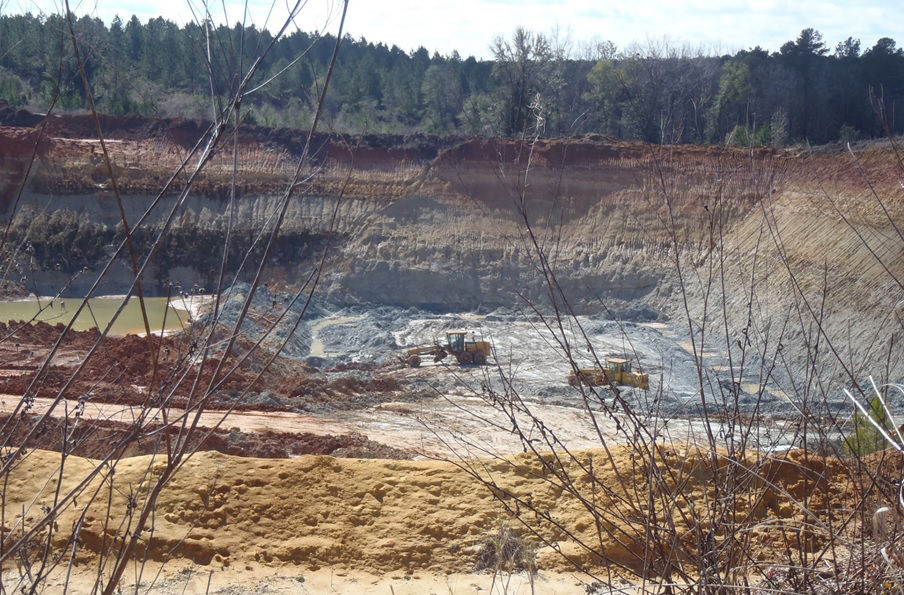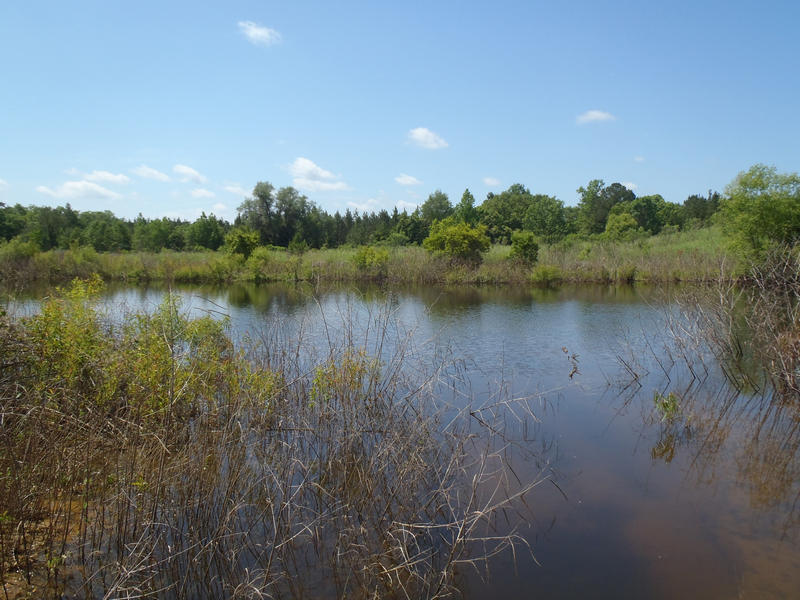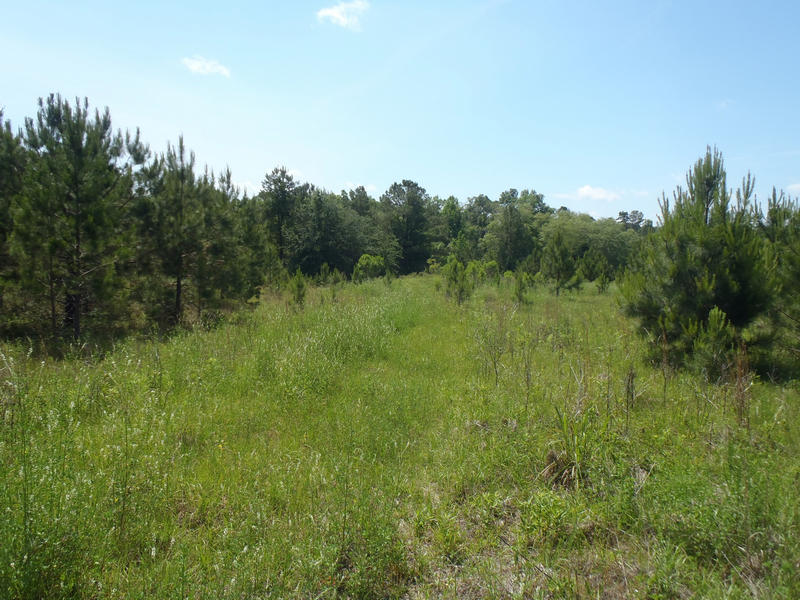There are 10 fuller’s earth mines in Florida. The fuller’s earth mines in Florida range from approximately 100-200 acres in size. The Mining and Mitigation Program administers reclamation and environmental resource/stormwater management permit programs for fuller's earth mining operations in Florida. The reclamation plans and standards required for fuller’s earth mining are detailed in Part II of Chapter 211, and Part III of Chapter 378, Florida Statutes (F.S.), and Chapter 62C-38, Florida Administrative Code (F.A.C.).
An Environmental Resource Permit (ERP) is also required for a fuller’s earth mining project. ERP standards are detailed in Part IV of Chapter 373, F.S., and Chapter 62-330, F.A.C.
What is fuller's earth?
Fuller's earth is clay that has been used for its absorbent properties since ancient times. It was used by "fullers" to "full" (remove) grease and fat from woolen cloth. Fuller's earth is a general term that can be applied to many types of clay that have an exceptional ability to absorb color from oils of animal, vegetable and mineral origin. In Florida, the term is narrowly defined.
Section 378.403(6), F.S., defines fuller's earth as clay possessing a high absorptive capacity consisting largely of montmorillonite or palygorskite (also known as attapulgite).
Where are the fuller's earth mines in Florida?
The first discovery in the U.S. of fuller’s earth was made in 1893 near Quincy, Florida. Mining began in Gadsden County in 1895. This ore deposit extends from Gadsden County, Florida, into Decatur and Grady counties, Georgia. An historic fuller’s earth mine exists in Marion County. The mine boundaries can be seen through Map Direct.
How is fuller's earth mined in Florida?
Fuller's earth occurs as a clay stratum. Over this is a sand and clay overburden that will not be sold. At some locations, there may be a second, deeper fuller's earth stratum. Overburden separates the two fuller’s earth strata.
Prior to mining, the trees may be harvested and the land is cleared. The topsoil and overburden are removed and stockpiled. The overburden may be contoured along the edge of the mine to contain sediment and stormwater within the mine during mining operations. The fuller's earth is excavated and loaded onto trucks for transport to the processing plant. After mining is complete, the topsoil and overburden may be used in reclamation to meet surface slope and revegetation requirements .
What are the reclamation standards for fuller’s earth mines?
The Florida Legislature requires reclamation of lands mined for fuller’s earth after July 1, 1975. Mine operators are required to provide the department with a conceptual reclamation plan. Part of our extensive evaluation of reclamation plan design includes analysis of public safety, water quantity impacts, consideration of best available technology, and focusing on preservation of wildlife habitat and resources.
Reclamation means the reasonable rehabilitation of land where resource extraction has occurred (Chapter 378.403, F.S.). Areas subject to the reclamation requirements must be reclaimed after mining is complete. Debris, litter, junk, worn-out or unusable equipment or materials are not allowed to remain on-site. The land must be contoured and stabilized for safety and erosion control. Bare areas must be revegetated.
Wetlands impacted by mining operations must be restored at least acre-for-acre and type-for-type. Reclamation standards for fuller's earth mines are detailed in Part III of Chapter 378, F.S. and Chapter 62C-38, F.A.C. The forms used for the reclamation program and filing instructions may be obtained online.
What permits are required for fuller’s earth mines?
There is no comprehensive permit that covers all aspects of large projects, including mines. An applicant may have to consider the requirements of several regulatory agencies. Each agency may regulate only the specific activities based on authority granted by Congress, the Florida Legislature or county commission. To start construction, the applicant must have all necessary federal, state and local approvals.
An Environmental Resource Permit (ERP) is required for fuller’s earth mines not included in a conceptual reclamation plan prior to July 1, 1996. The Mining and Mitigation Program reviews applications for Environmental Resource Permits (ERPs). Activities that typically require an ERP include dredging and filling located in, on or over wetlands or other surface waters, as well as the construction of structures.
The permit governs the construction, alteration, operation, maintenance, repair, abandonment and removal of stormwater management systems, including dams, impoundments, reservoirs, appurtenant works and works. The rules used to implement the ERP are authorized under Chapter 373, F.S. ERPs are also subject to Chapter 403, F.S., which governs activities which may pollute ground or surface waters, including wetlands.
Chapter 62-330, F.A.C., and the Applicant's Handbook, Volume I, and Applicant’s Handbook Volume II, provide explanations, procedures, guidance, standards and criteria for ERPs. The forms used for the ERP program and filing instructions may be obtained online. The state of Florida utilizes a joint application for the ERP and State 404 permitting programs.
Fuller’s earth mines included in a conceptual reclamation plan prior to July 1, 1996, may be required to have a Wetland Resource Permit (WRP) instead of an ERP. This permit is based on statutes and rules in effect on Jan. 1, 1993. This permit is required for dredging or filling in, on or over wetlands and other surface waters unless the activity is specifically exempted by statutes or rules. WRPs are issued under Chapter 62-312, F.A.C.
How does the department monitor activities at fuller’s earth mines?
Each operator provides the department with an Annual Mining and Reclamation Report describing activities for the previous calendar year, and proposed mining and reclamation activities for the current year. The ERP or WRP permit may require additional monitoring reports.
Routine compliance inspections are conducted to ensure that mining and reclamation activities follow permit and reclamation rules.
How can you obtain public records?
You can obtain a list of applications for permits and conceptual reclamation plans that are currently under review with the department. This will provide the application number which can be used when requesting public records.
The Florida Department of Environmental Protection maintains public records in an electronic document management system. You can obtain public records relating to applications, plans, reports and inspections through either of these websites:
You may also request public records by contacting the Mining and Mitigation Program at MiningAndMitigation@FloridaDEP.gov or 850-245-8336.
For More Information
Florida Department of Environmental Protection
Mining and Mitigation Program
2600 Blair Stone Road, Mail Station 3577
Tallahassee, FL 32399
850-245-8336 (phone) / 850-245-8356 (fax)
MiningAndMitigation@FloridaDEP.gov





